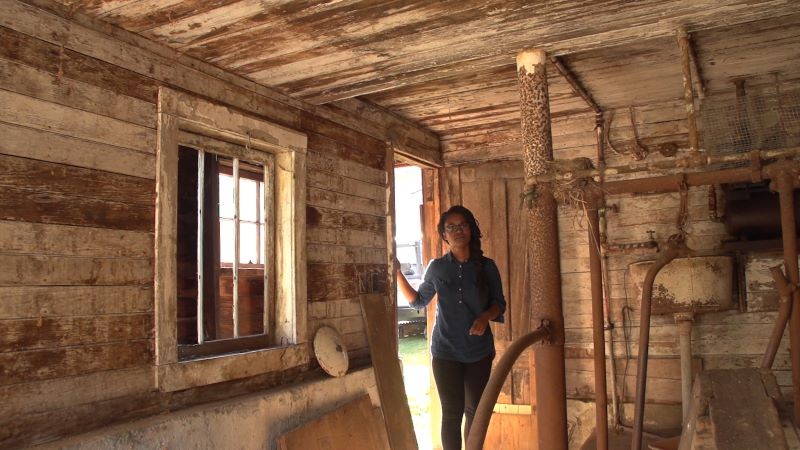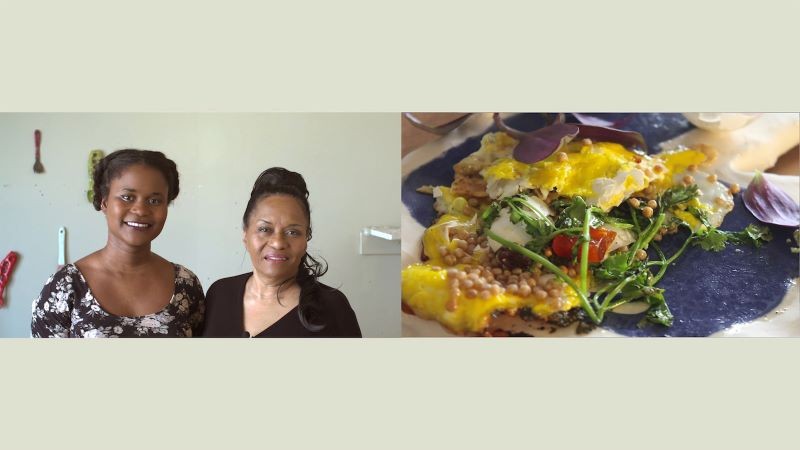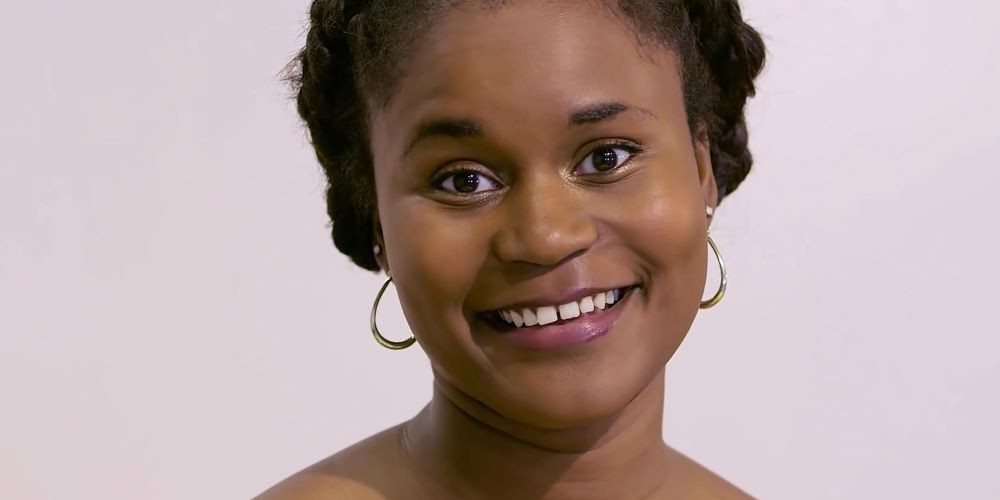Uncovering the Heritage Silhouette: Ilana Harris-Babou '16
Uncovering the Heritage Silhouette is a bi-weekly series diving into how tradition influences the creation of art. We interview artists heavily influenced by their heritage.
Ilana Harris- Babou ’16 is an interdisciplinary artist whose work spans sculpture and installation, grounded in video. She is based in Brooklyn, New York. She speaks the aspirational language of consumer culture and uses humor as a means to digest painful realities. Her work confronts the contradictions of the American Dream: the ever unreliable notion that hard work will lead to upward mobility and economic freedom. She has exhibited throughout the US and Europe, with solo exhibitions at The Museum of Arts & Design, Larrie, 80WSE, and HESSE FLATOW in New York. Other venues include Abrons Art Center, the Jewish Museum, SculptureCenter, the Studio Museum in Harlem, the De Young Museum, and the 2019 Whitney Biennial. Her work is in the permanent collection of the Whitney Museum of American Art. She has been reviewed in the New Yorker, Artforum, and Art in America, among others. She holds an MFA in Visual Art from Columbia University, and a BA in Art from Yale University.
What does cultural heritage mean to you?
Ilana Harris-Babou: I think of what is inherited, such as traditions we are aware of, the ancestors that came before us, the lineage and history of what people have done or behaved in the places we are in. Sometimes that heritage is named, other times not. Sometimes it is celebrated, other times it's ignored. I associate one’s cultural heritage with their own want to continue cultural traditions and norms that we have a desire to continue for.
What are some of the main concepts or themes you explore in your videos?
IHB: In my work in general I tend to gravitate towards what I call “aspirational media.” This includes cooking shows or home improvement where there is a host who creates a perfect world. They make their own space, surround themselves with things they have purchased and often these things come with the promise of the American dream or success story.
I often begin simply trying to mimic these forms but because I am human, I inevitably fail. I lay out the failures bare in the editing process and I allow these moments to become strange in their ways. These moments become the project’s vulnerability amongst the familiar images. I hope to destabilize people’s expectations surrounding the visual culture more generally, but also the history that comes along with it.

The fake hardware store you created in 2018, Reparation Hardware, features reclaimed furniture to create sculptures that reflect the notion of making the old new again. How did this project start?
IHB: The project began when I was doing my Fountainhead Fellowship in Virginia that was funded by a real estate company. I was living on their property and it was my first time living alone so I was not used to the amounts of silence. So I often left the TV playing, often home and garden programs. I naturally got really interested in those characters.
At that fellowship I finished up a video with my mom called Finishing a Raw Old Basement. During all of this was the 2016 elections and I was living in this city where we crossed the Robert E. Lee bridge to get to work everyday. It felt like a giant confederate monument of the city sometimes. This made me think a lot about the civil war and unfinished business, unresolved history.
Working on the home improvement show work, I repeatedly said “repair” a lot. The language in my videos comes from repetition and a lot of ad-libbing from the different sources. I was thinking a lot about what was unfixed and this project came forward.
What was the main inspiration of the piece and what discussion did it lead into?
IHB: The project is inspired by Youtube videos of Restoration Hardware, the high end furniture company. In those videos, whenever they release a new line of furniture, there is usually a designer standing in front of a really bucolic landscape talking in very vague terms about where they find inspiration. It made me wonder why we want to have these things in our homes, these expensive pieces of furniture.
To me it was a way to take the past into your home tastefully. So my question in Reparation Hardware became, “Why is the notion of reparation so terrifying for so many folks?” Especially given the time since it was something many politicians were not talking about in a real way. In some ways it names the past as an economic failure. So I decided to launch my own line that was a reparation for Black Americans.
The project makes one think about who does and does not have access to homeownership and what do those systems of exclusion look like. The store critiques double standards and the modern American ideals of life within the home. The store suggests political messages that reflect the emancipation and equality of African-Americans in the United States.

You painted the hardware with a “plantation line of pigments.” What is the significance of doing so? What about the other objects featured in the store?
IHB: I guess I was looking for a color to paint the wall and I was looking through Benjamin Moore’s paints and found “plantation tan.” I like to see how words can shift in meaning when put into different contexts.
I made these lamps while thinking about the ceramic hammer. It is a tool that would undue itself through its very use. I would ask myself, “Is the American project such a tool?” I made some of these lamps out of piles of ceramic hammers.
Your 2016 video, Cooking with the Erotic, features yourself and your mother doing a mock-cooking show. How did your interest in cooking shows and media begin?
IHB: Before this I was making a lot of paintings and getting frustrated with those. The finished works were just sitting artifacts. Switching over to video was a way to show people the moment when the painting was still wet, messy, and in a state of becoming.
Before starting my MFA, I was in New York watching a lot of music videos and that form. They became my models for when I first started making videos. I was interested in the aspiration there and how studio lighting could make anything look seductive, or valuable. These intentions grew and cooking shows came to mind.

What was the inspiration behind this particular cooking video?
IHB: I was thinking a lot about where my own recipes come from. I was looking through a lot of cookbooks by artists. From there I just find bits where people talk about food becoming themselves.
During my time at Columbia I took a critical issues class and a guest speaker mentioned Audre Lorde’s The Cancer Diaries. This led me to Sister Outsider and uses of the erotic. I was really excited by the speech the speaker was giving, particularly the part where she spoke about needing a bag of margarine during World War II. She said she wanted to see the kernel within herself, the erotic within herself that can be released and allowed to spread.
How did this result in choosing ‘taste’ as your theme?
IHB: My mother was living in a house in Connecticut with my grandmother as the house’s maid. I saw a lot of resonance with Lorde’s stories and my mom’s lived experiences. That became the starting point of the cooking show where taste is something that can taste good, but something can also be distasteful or disdain. Taste holds multiple meanings, it can be someone speaking out of turn, certain paints, the unexpected, and more. What does it mean for something to be in good taste or poor taste? This is something we often take for granted, especially artists who are often described as arbiters of taste but don’t necessarily take to heart. Often artists overlook what that might truly mean. It’s a recurring theme because I often work with things that I’m attracted to whether it’s the recipes on the show, the furniture, or the beauty products. I think about what makes me covet and desire these products. I think about what is my own and what objects are implanted.
Your mother plays a large role in your life and your artistic journey. What has she bestowed on you that has become your inspiration?
IHB: I always wonder in what ways everyone’s lives are just a collaboration with their parents. My mom definitely doesn’t cook and the only time she went into the kitchen was to go stand in front of this big wall of mirrors we had. She would look there and do a Julia Childs imitation almost, speaking in her accent. My mom is a troll and that side of play I definitely think she shares with me. I’m a Capricorn so I’m a bit more pragmatic and she gets me to be more wild.

Your mother was featured again in your more recent exhibition, Decision Fatigue, at Hesse Flatow in New York City. Here she is conducting a makeup tutorial. What is this project about and what are the reflections incited?
IHB: This video started with sculptures that I had made. I laid them down on the table and she made up stories around them. The whole video was mostly her doing ad-libs without any particular external source being referenced. She has watched a lot of beauty demo videos and has the lingo down.
I have been looking at how the ideas in my work manifest in the wellness industry. Terms like ‘pure product’ or ‘clean eating’ are a form of security we often take for granted. I was doing a residency in the Hamptons and noticed this Hamptons beauty magazine called The Purist Online: An Adventure in Wellness. There is something very sinister in all of that and I was thinking about the obsession with mommy culture also. The ways that lead to supposedly becoming a good mom are regressive in many ways. I took notice of the ways popular culture around me would frame femininity. I took those images and made them grotesque, unnatural, and unclean.
In the video, Mother goes through a daily beauty tutorial and reflects on her choices to appear youthful and healthy, questioning the reality of her youth. I use this video to examine how structural problems are sometimes concealed as personal choices. The exhibit also features sculptures that are similar to items found in a boutique but altered to appear abnormal.
You often incorporate humor, which you say is “a means to digest painful realities.” Can you talk more about that?
IHB: When I’m filming I like to think the person there is not me, just me physically. I’m very much improvising with the items in front of me in the studio. It’s more about entering a way of thought. There is no direct strategy to incorporate humor. It is more the result of lack of strategy. Then leaving the failures that I spoke about before, it becomes funny. This is also a way to think about time or timing that can have a comedic effect. I think a lot about the timing it takes for something to become enticing but not yet instructive. And if you see something for too long it becomes banal or grotesque. Sometimes I purposely like to stick one toe over the time we are used to looking at a video at a screen. That dissonance can also generate humor.
To me the clearest way to digest painful realities is the sugar coating on the outside of a Tylenol tablet that lets you inject the bitter medicine you really need. The most painful things are usually the funniest things.
What are you working on now?
IHB: Going into the pandemic I was thinking about health and wellness. Over the course of the year I was still thinking about how structural issues are framed as personal choices. I started getting inspirations from wellness and health gurus that speak from a place of self determination. I have been looking a lot at Doctor Sabi, a wellness guru through the 80s, who introduced a new diet that became the most googled diet of 2019. He worked with a lot of Black celebrities. He argued that Black people were dying because they were eating foods that we were not meant to be eating. He had a lot of pseudoscience. There is a large conspiracy theory surrounding him and his expensive supplements. The world of his fans and him on the internet is very interesting to me.
I have been making a piece for a magazine that has an issue coming out focused on nationhood. Doctor Sabi quotes this line that I believe was said a few times in the bible: “The leaves and the herbs of the tree of life were for the healing of the nation.” I was interested in food as national healing and him as a stateless character. I was thinking about what it was like to be a conman in a place where the structure is largely a con. This is what I’m thinking about in the piece. I am working with appropriated footage and creating a sort of animated collage of conversations with my sister who tried the Doctor Sabi diet. It is going to be a webbed piece that is a progression of shorter videos laid out on the magazine’s website.
Read more from the "Uncovering the Heritage Silhouette" series
